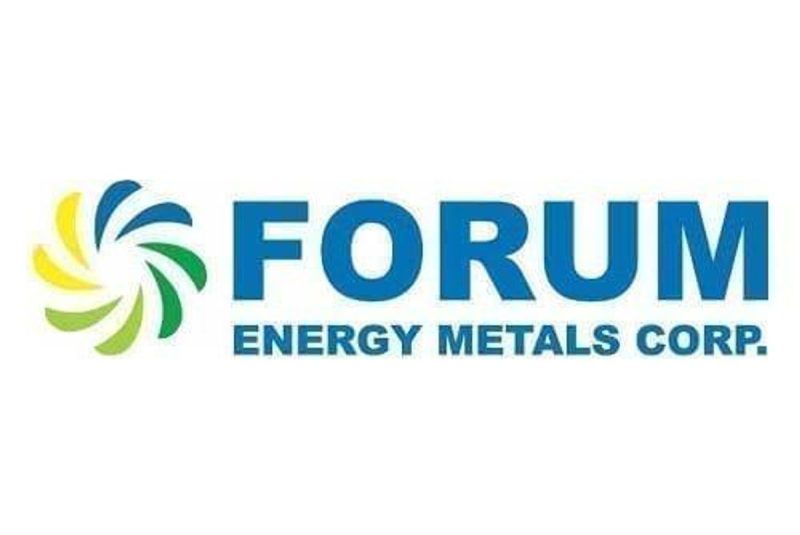
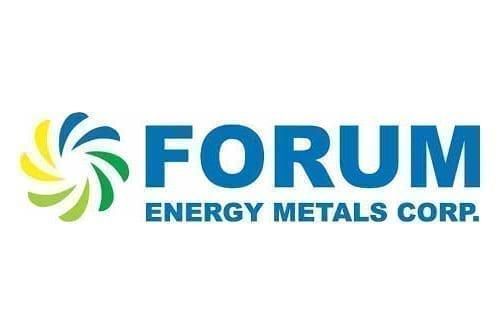
Forum Energy Metals Corp. (TSXV: FMC) (OTCQB: FDCFF) (‘Forum’ or the ‘Company’) announces the first set of results from its 30 hole, 6,962 m summer drill program at its Aberdeen Uranium Project, located five kilometres to the west of the 133 million pound Kiggavik uranium project held by OranoDenisonUEC*. Forum has received 608 geochemical results from the 11 holes drilled to follow-up the successful 2023 program at the mineralized Tatiggaq Main and West zones. Seven of eleven holes were mineralized. Significant results are highlighted below.
HIGHLIGHTS
Tatiggaq Main
- TAT24-012 intersected 1.15% U3O8 over 2.4 m from 169.1 to 171.5 m including:
- 3.33% U3O8 over 0.3 m (169.7 – 170.0 m)
- 2.77% U3O8 over 0.5 m (170.4 – 170.9 m)
- TAT24-014 intersected 1.31% U3O8 over 7.6 m from 164.0 to 171.6 m including:
- 4.56% U3O8 over 0.2 m (166.4 – 166.6 m)
- 4.30% U3O8 over 0.5 m (169.1 – 169.6 m)
- 4.81% U3O8 over 0.4 m (171.2 – 171.6 m)
- Including a maximum grade of 8.15% U3O8 over 0.2 m (171.4 – 171.6)
- Entire mineralized interval at TAT24-014 is 0.62% U3O8 over 17.9 m from 157.9 to 175.8 m
Tatiggaq West
- TAT24-011 intersected 35.3m grading 0.11% U3O8 from 144.2 to 179.5 m including 0.68% U3O8 over 1.6 m (170.9 to 172.5 m) including:
- 1.24% U3O8 over 0.4 m (171.2 – 171.6 m)
- 1.12% U3O8 over 0.3 m (172.0 – 172.3 m)
- Uranium mineralization at the Main zone has been encountered over a thickness of ~35 metres in 2024.
- Drilling at Tatiggaq West intersected thick intervals of continuous uranium mineralization for another 40 m to the west.
- The total strike extent of uranium mineralization drilled at the Main and West zones has increased from 200m to over 310 metres
- TAT24-005, TAT24-008, TAT24-009 and TAT24-010 intersected proximal alteration types (strong clay, bleaching, sulphide) and elevated counts indicative of uranium mineralization nearby that require follow-up.
- Results are pending for the remaining 8 holes targeting multiple parallel structures within the large Tatiggaq gravity anomaly measuring 1.5 km by 0.7 km, in addition to the 11 holes testing the Qavvik, Ayra, Ned, and Loki regional targets.
Dr. Rebecca Hunter, Forum’s VP, Exploration stated, ‘Drilling at Tatiggaq Main has intersected another parallel lense of high-grade uranium extending the width to 35 metres and could be thicker. I am pleased that Tatiggaq West shows lateral continuity and thickness to the west and remains open along strike and at depth. The complex, structurally-controlled nature of these zones will be evaluated with further infill drilling and drilling along strike of the Tatiggaq Fault in 2025. We look forward to receiving the results from 8 holes along parallel structures in the Tatiggaq anomaly, as well as 11 holes drilled at Qavvik, Ned, Loki and Ayra.’
Tatiggaq Interpretation and Follow-up Drilling
Cameco drilled 38 holes on the Tatiggaq Main and West zones prior to Forum’s acquisition of the project by staking in 2021. Forum’s 2023 and 2024 drill programs were formulated to infill and extend areas within the inferred mineralization to commence development of a maiden resource. Figure 1 shows the 2024 drill hole locations and the main east-northeast structures (Thelon and Judge Sissons faults) as well as the numerous, sub-parallel subsidiary east-northeast structures interpreted to control uranium mineralization on Orano’s and Forum’s property. Figure 2 is a plan map showing the 2024 drill collars in the vicinity of the Tatiggaq Main and West areas. Figures 3 and 4 show cross sections through the Tatiggaq Main and West zones. Figure 5 is a photo of the main mineralized interval from TAT24-014, which was lost at 176 m. Table 1 and 2 are results for mineralized drillholes in Tatiggaq Main and West.
Drilling in 2023 and now 2024 has resulted in a greater understanding of the style and geometry of the Tatiggaq mineralization:
- U mineralization is hosted in steep, discreet lenses that can vary in grade and thickness along strike and width for a length of 310 m (West and Main).
- Individual lenses vary in thickness from
- Mineralization depth ranges between 80 and 200 m.
- Tatiggaq Main has 3 to 5 thicker, high-grade lenses (up to 12 m thick and grades > 1%, locally > 20%).
- Tatiggaq West has 5 to 12 narrower, lower grade lenses (up to 35 m thick in total, grades ~0.1%, locally >1%).
- Due to the discreet structurally hosted nature of the mineralization at Tatiggaq and the northwest trending network of cross faults, future drilling at close step-outs will be required.
Table 1 2024 Drill Hole Data for the Tatiggaq Main and West areas. (UTM collars are in datum WGS84 Zn 14N)
| Hole ID | Target | Easting | Northing | Elev. | Depth | Orient. | Comment |
| TAT24-005 | West | 548837 | 7135330 | 187 | 293.0 | -65° / 320° | Elevated (184 ppm), altered – proximal |
| TAT24-006 | Main | 548986 | 7135471 | 188 | 230.0 | -66° / 308° | Mineralized |
| TAT24-007 | West | 548799 | 7135365 | 187 | 227.0 | -64° / 316° | Mineralized |
| TAT24-008 | West | 548782 | 7135389 | 187 | 236.0 | -66° / 309° | Elevated (100 ppm), altered – proximal |
| TAT24-009 | Main | 548997 | 7135453 | 187 | 275.0 | -65° / 314° | Elevated (108 ppm), altered – proximal |
| TAT24-010 | Main | 549032 | 7135475 | 187 | 238.3 | -65° / 310° | Elevated (39 ppm), altered – proximal |
| TAT24-011 | West | 548772 | 7135316 | 189 | 236.0 | -66° / 310° | Mineralized |
| TAT24-012 | Main | 548927 | 7135447 | 187 | 248.0 | -69° / 317° | Mineralized – High Grade |
| TAT24-013 | West | 548732 | 7135311 | 187 | 239.0 | -66° / 314° | Mineralized |
| TAT24-014 | Main | 548927 | 7135447 | 187 | 176.0 | -75° / 315° | Hole lost in High Grade Mineralization |
| TAT24-015 | West | 548732 | 7135311 | 187 | 230.0 | -73° / 310° | Mineralized |
Table 2 – U3O8 assay results for mineralized drill holes at Tatiggaq West and Main using a 0.01% cutoff.
| Hole ID | From_m | To_m | Interval_m | U3O8_% |
| TAT24-006 | ||||
| Upper Lense | ||||
| 157.9 | 160.9 | 3.0 | 0.13 | |
| including | 158.3 | 159.2 | 0.9 | 0.30 |
| including | 160.0 | 160.3 | 0.3 | 0.32 |
| Lower Lense | ||||
| 163.7 | 166.0 | 2.3 | 0.07 | |
| including | 164.5 | 164.8 | 0.3 | 0.19 |
| including | 165.5 | 166.0 | 0.5 | 0.11 |
| TAT24-007 | ||||
| Main Lense | ||||
| 99.8 | 101.5 | 1.7 | 0.17 | |
| including | 100.3 | 101.0 | 0.7 | 0.40 |
| TAT24-011 | ||||
| Entire Interval | ||||
| 144.2 | 179.5 | 35.3 | 0.11 | |
| Subdivided Into Lenses | ||||
| 148.2 | 149.5 | 1.3 | 0.11 | |
| 152.4 | 153.5 | 1.1 | 0.17 | |
| 161.4 | 162.8 | 1.4 | 0.26 | |
| including | 162.4 | 162.6 | 0.2 | 1.18 |
| 165.0 | 166.3 | 1.3 | 0.20 | |
| 170.9 | 172.5 | 1.6 | 0.68 | |
| including | 171.2 | 171.6 | 0.4 | 1.24 |
| including | 172.0 | 172.3 | 0.3 | 1.12 |
| 173.7 | 175.6 | 1.9 | 0.13 | |
| 175.8 | 176.9 | 1.1 | 0.29 | |
| 178.8 | 179.0 | 0.2 | 1.30 | |
| TAT24-012 | ||||
| Upper Lense | ||||
| 151.4 | 151.7 | 0.3 | 0.15 | |
| Middle Lense | ||||
| 169.1 | 171.5 | 2.4 | 1.15 | |
| including | 169.7 | 170.0 | 0.3 | 3.33 |
| including | 170.4 | 170.9 | 0.5 | 2.77 |
| Lower Lenses | ||||
| 187.7 | 188.1 | 0.4 | 0.19 | |
| 196.1 | 196.3 | 0.2 | 0.13 | |
| 199.1 | 199.6 | 0.5 | 0.12 | |
| TAT24-013 | ||||
| Entire Interval | ||||
| 144.0 | 171.9 | 27.9 | 0.07 | |
| Subdivided Into Lenses | ||||
| 144.0 | 148.1 | 4.1 | 0.11 | |
| including | 146.3 | 146.5 | 0.2 | 0.47 |
| 155.0 | 157.0 | 2.0 | 0.27 | |
| including | 155.0 | 155.9 | 0.9 | 0.51 |
| including | 156.9 | 157.0 | 0.1 | 0.91 |
| 170.8 | 171.9 | 1.1 | 0.11 | |
| TAT24-014 | ||||
| Entire Interval | ||||
| 157.9 | 175.8 | 17.9 | 0.62 | |
| Upper Lense | ||||
| 157.9 | 164.0 | 6.1 | 0.11 | |
| including | 158.9 | 159.4 | 0.5 | 0.16 |
| including | 161.8 | 163.5 | 1.7 | 0.18 |
| Middle Lense | ||||
| 164.0 | 171.6 | 7.6 | 1.31 | |
| including | 164.0 | 165.2 | 1.2 | 2.40 |
| including | 166.4 | 166.6 | 0.2 | 4.56 |
| including | 167.1 | 167.6 | 0.5 | 1.35 |
| including | 169.1 | 169.6 | 0.5 | 4.30 |
| including | 171.2 | 171.6 | 0.4 | 4.81 |
| max grade | 171.4 | 171.6 | 0.2 | 8.15 |
| Lower Lense | ||||
| 171.6 | 175.8 | 4.2 | 0.09 | |
| including | 172.7 | 172.9 | 0.2 | 0.14 |
| including | 174.2 | 174.6 | 0.4 | 0.19 |
| including | 175.4 | 175.8 | 0.4 | 0.33 |
| Hole was lost in mineralized interval | ||||
| TAT24-015 | ||||
| Upper Lense | ||||
| 148.4 | 161.7 | 13.3 | 0.08 | |
| Subdivided Into Lenses | ||||
| 149.5 | 151.0 | 1.5 | 0.16 | |
| including | 149.7 | 149.8 | 0.1 | 0.37 |
| 152.0 | 152.4 | 0.4 | 0.35 | |
| 158.0 | 160.4 | 2.4 | 0.12 | |
| Lower Lense | ||||
| 183.8 | 186.4 | 2.6 | 0.11 | |
| including | 183.8 | 184.8 | 1.0 | 0.16 |
*Source: The Kiggavik deposit is held by Orano (66.2%), Denison (16.9%) and Uranium Energy Corp. (16.9%). Kiggavik mineral resources are 127.3 million pounds Indicated mineral resource grading 0.55% U3O8 and 5.4 million pounds Inferred mineral resource grading 0.33% U3O8 as reported on the Denison Mines Ltd. Corporate Presentation dated November 2024, p. 23 on their website and the Orano 2023 Activities Report converted from tonnes U to pounds U3O8 and from %U to %U3O8 . Cut-off grades and other assumptions, parameters and methods used to estimate resources are unknown. A qualified person has not done sufficient work to classify the historical estimate as current mineral resources or mineral reserves and the issuer is not treating the historical estimate as current mineral resources or mineral reserves.
Rebecca Hunter, Ph.D., P.Geo., Forum’s Vice President of Exploration and Qualified Person under National Instrument 43-101, has reviewed and approved the contents of this news release.
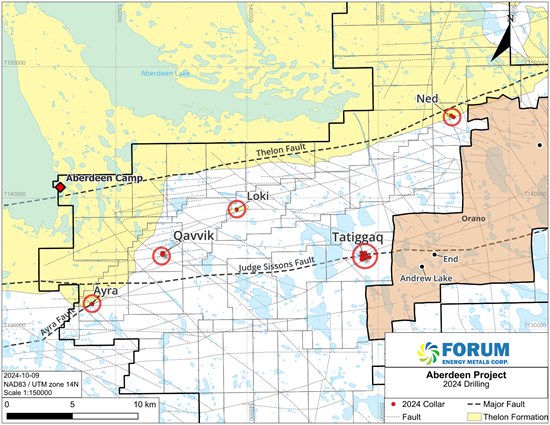
Figure 1 Property map with the locations of the 2024 diamond drilling program on the Aberdeen Project.
To view an enhanced version of this graphic, please visit:
https://images.newsfilecorp.com/files/4908/231363_a5b8cfc8c48dc95d_003full.jpg
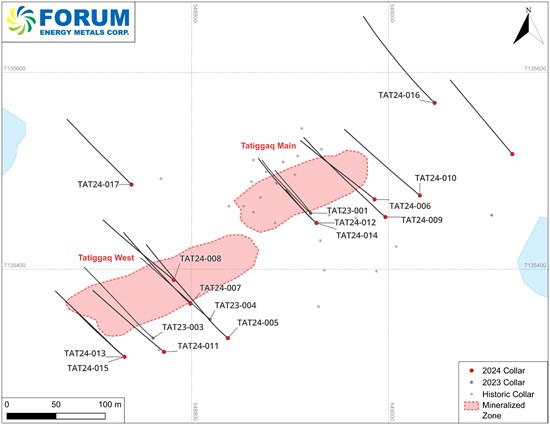
Figure 2 The location of the 2024 Tatiggaq drilling within the southwest part of the overall anomaly, historical drilling and Forum’s 2023 drill holes. We are presenting results from drill holes TAT24-005 to TAT24-015. Note: TAT23-001 and TAT23-002 have the same collar (2023 drill holes)
To view an enhanced version of this graphic, please visit:
https://images.newsfilecorp.com/files/4908/231363_a5b8cfc8c48dc95d_004full.jpg
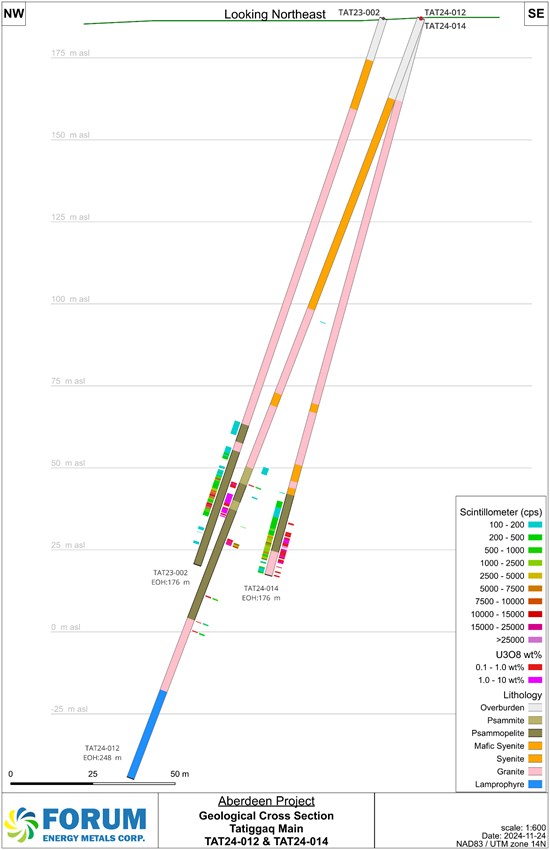
Figure 3 Cross-section showing drill holes TAT23-002 (2023 drill hole), and TAT23-012 and TAT24-014 with lithology, scintillometer results and assay results.
To view an enhanced version of this graphic, please visit:
https://images.newsfilecorp.com/files/4908/231363_a5b8cfc8c48dc95d_005full.jpg
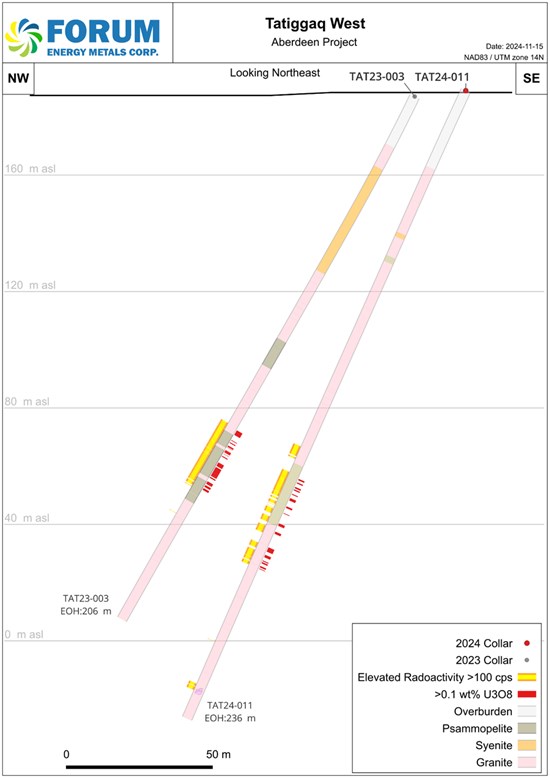
Figure 4 Cross-section showing drill holes TAT23-003 (2023 drill hole) and TAT24-011 with lithology, scintillometer and assay results.
To view an enhanced version of this graphic, please visit:
https://images.newsfilecorp.com/files/4908/231363_a5b8cfc8c48dc95d_006full.jpg
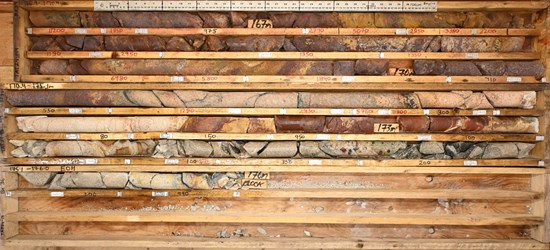
Figure 5 TAT24-014 drill core from the mineralized section at approximately 166.5 – 176.0 m. The uranium mineralization is largely hosted in steep brittle structures within a psammopelitic and granitic unit. Scintillometer readings are written on the core boxes in counts per second and were measured using a digital, hand-held CT-007M scintillometer by Environmental Instruments Canada Inc.
To view an enhanced version of this graphic, please visit:
https://images.newsfilecorp.com/files/4908/231363_a5b8cfc8c48dc95d_007full.jpg
Quality Assurance and Quality Control (QA/QC)
Forum implemented a robust QA/QC program for its 2024 drill program, expanding upon the program used in 2023. The 2024 QA/QC program utilized control samples comprising certified reference materials (CRMs), duplicates, and blank samples. CRMs were used to monitor laboratory accuracy in the analysis of mineralized and non-mineralized samples, duplicate samples were used to monitor analytical precision and repeatability at the preparation and analytical stages, and blank samples were used to monitor for cross contamination during preparation and analytical stages.
Control samples were inserted every 10th sample, alternating between blank, duplicate, and uranium CRM. Duplicate samples alternated between field, coarse, and pulp duplicates. Three low grade uranium CRMs were alternated between: BL-4a (0.1248% U), DH-1a (0.2629% U), and BL-2a (0.426% U). A high-grade uranium CRM (BL-5; 7.09% U) was inserted into the sample sequence when counts exceeded 10,000 cps. Blanks and duplicates were inserted at a rate of 1-in-20 in non-mineralized holes. For mineralized holes, blanks, duplicates, and uranium CRMs were inserted at a rate of 1-in-30.
In addition to Forum’s QA/QC program, SRC Geoanalytical Laboratories (SRC) conducted an independent QA/QC program, and its laboratory repeats, non-radioactive laboratory standards (BSL18, BSM, BSH, DCB01), and radioactive lab standards (BL2A, BL4A, BL5, and SRCU02) were monitored and tracked by Forum staff.
Downhole Radiometric Probing Method
Of the 30 holes completed in 2024,18 were successfully radiometrically probed using a 2GHF-1000 Triple Gamma downhole probe sourced from Terraplus in Ontario, Canada. The probe measures natural gamma radiation every 10 cm along the length of the drill hole. The total count NaI, which reports in count per second (cps), may not be directly or uniformly related to uranium grades and are only an indication of the presence of radioactive minerals. We do not calculate equivalent radiometric grades at this time (eU3O8).
Sample Collection Methods
Forum geologists mark sample intervals and sample types to be collected based on geological features in the core and on radioactivity measured with the CT-007M from Environmental Instruments Canada Inc.
in counts per second (cps). Several types of drill core samples are collected: systematic basement (Syst_B), composite sandstone (Comp_S), spot (Spot_B or Spot_S), and Assay. Systematic basement samples consist of a split-core sample, approximately 10 cm long, collected every 10 m in non-mineralized basement rock. One half of the core is collected for geochemical analysis while the remaining half is returned to the core box for storage on site. Composite sandstone samples are comprised of a chip or disk of core collected from the start of each row in the core box over 10 m intervals in non-mineralized sandstone. Split-core spot samples are collected from non-mineralized but geologically significant alteration, structures, or features in basement and sandstone. Spot samples vary in size depending on the feature being sampled but are generally 0.1 m in length. Assay samples are collected continuously through zones of radioactivity above 250 CPS, as measured by the CT-007 microR meter. Assay samples are between 0.1 and 0.5 m in length and are dictated by the level of radioactivity, where similar counts per second are grouped together. One half of the core is collected for geochemical analysis while the remaining half is returned to the core box for storage on site. Shoulder assay samples are collected for 1-2 metres above and below mineralized zones.
All depths and intervals reported in this release are drill hole depths and intervals and do not represent true thickness unless otherwise stated.
About Forum Energy Metals
Forum Energy Metals Corp. (TSXV: FMC) (OTCQB: FDCFF) is focused on the discovery of high grade unconformity-related uranium deposits in the Athabasca Basin, Saskatchewan and the Thelon Basin, Nunavut. In addition, Forum holds a diversified energy metal portfolio of copper, nickel, and cobalt projects in Saskatchewan and Idaho.
For further information: https://www.forumenergymetals.com.
This press release contains forward-looking statements. Forward-looking statements address future events and conditions and therefore involve inherent risks and uncertainties. Actual results may differ materially from those currently anticipated in such statements. Forward-looking information is subject to known and unknown risks, uncertainties and other factors that may cause Forum’s actual results, level of activity, performance or achievements to be materially different from those expressed or implied by such forward-looking information. Such factors include but are not limited to: uncertainties related to the historical data, the work expenditure commitments; the ability to raise sufficient capital to fund future exploration or development programs; changes in economic conditions or financial markets; changes commodity prices, litigation, legislative, environmental and other judicial, regulatory, political and competitive developments; technological or operational difficulties or an inability to obtain permits required in connection with maintaining or advancing its exploration projects.
ON BEHALF OF THE BOARD OF DIRECTORS
Richard J. Mazur, P.Geo.
President & CEO
Neither the TSX Venture Exchange nor its Regulation Services Provider (as that term is defined in the policies of the TSX Venture Exchange) accepts responsibility for the adequacy or accuracy of this release.
For further information contact:
Rick Mazur, P.Geo., President & CEO
mazur@forumenergymetals.com
Tel: 604-630-1585
To view the source version of this press release, please visit https://www.newsfilecorp.com/release/231363

News Provided by Newsfile via QuoteMedia
